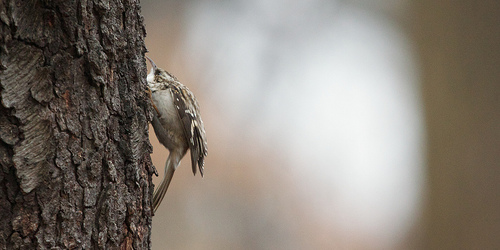That’s a mighty fine pygostyle you’ve got there…
I recently read in the book Wild Bird Guides: Downy Woodpecker by Gary Ritchison, that the anatomical structure that allows woodpeckers to use their tails as props is called a “pygostyle.” A cool name that stuck with me, because when I saw the Brown Creeper using its tail in the same posture, “pygostyle” popped in my head, and I wondered if a Brown Creeper’s pygostyle was similar to a woodpecker’s. After looking in a few books and doing a few Internet searches, I found it was.

The naturalist W.M. Tyler, writing in 1948, captured this species’ energy and fragility in a memorable description, “The Brown Creeper, as he hitches along the bole of a tree, looks like a fragment of detached bark that is defying the law of gravitation by moving upward over the trunk, and as he flies off to another tree he resembles a little dry leaf blown about by the wind.” Brown Creeper – All About Birds photo by qmnonic
How is it different?
The pygostyle in a bird is made from 4-10 fused posterior caudal vertebrae…basically, it’s the bird’s tail bone (like our coccyx). The pygostyle and the muscles around it give support to the tail feathers (rectrices), and while all birds have a pygostyle, not all pygostyles are the same. For example, the bones in a woodpecker’s and creeper’s pygostyle are much larger and the muscles surrounding it are much stronger than those in an average bird’s tail. Most birds fly and perch on branches, but woodpeckers and creepers cling to and walk up the vertical surface of a tree trunk. Their tails help them stay in place because they work like a prop….
Read the whole article from Red and the Peanut (a fine bird blogger)
Discover more from Vermont Birder
Subscribe to get the latest posts sent to your email.
